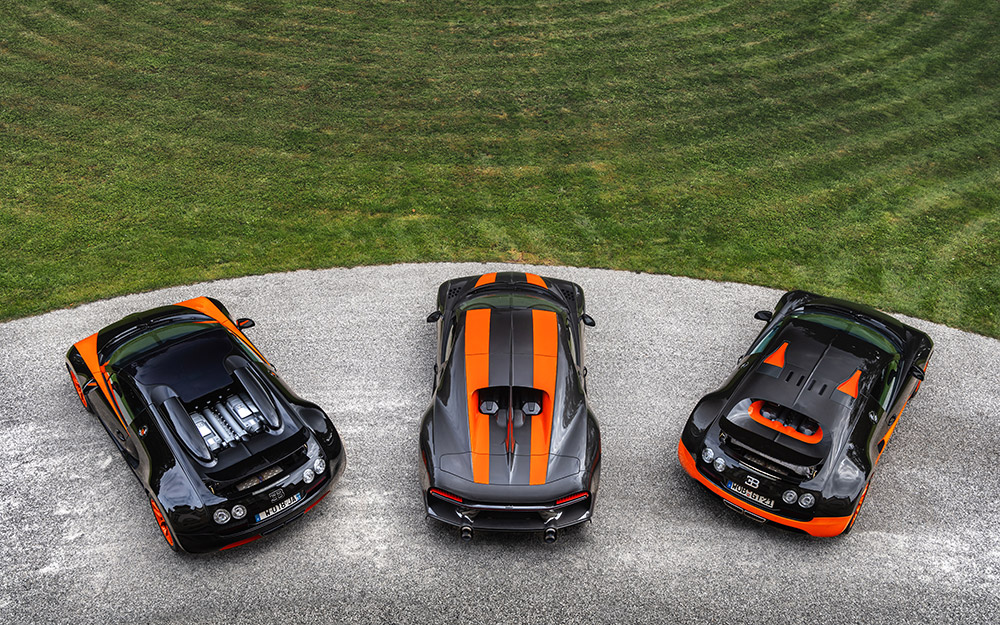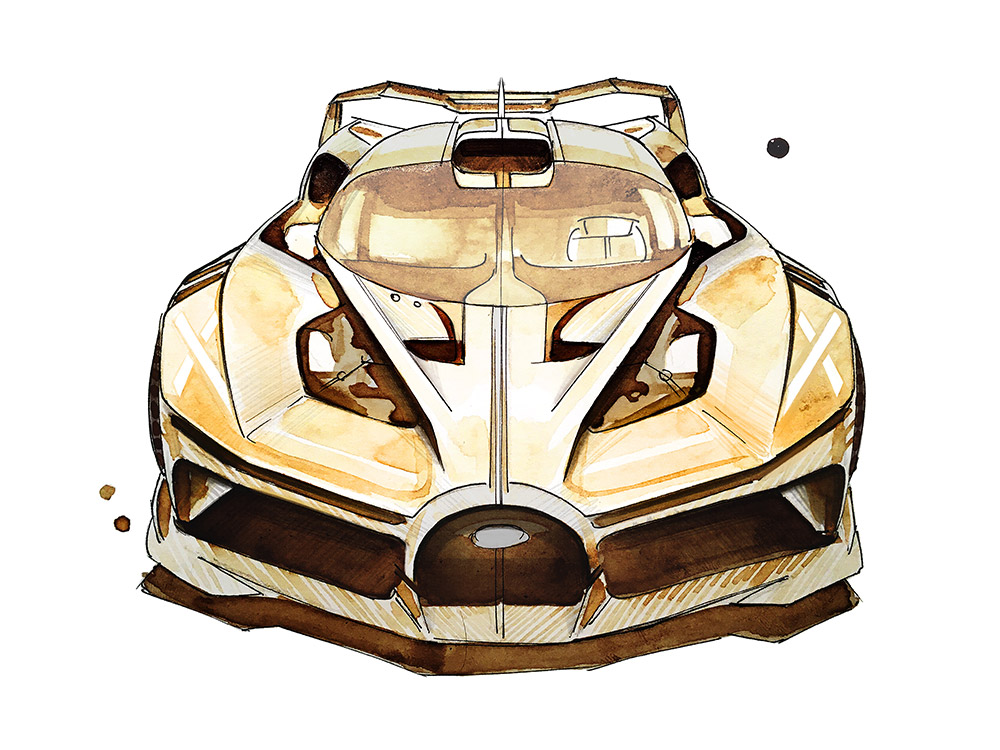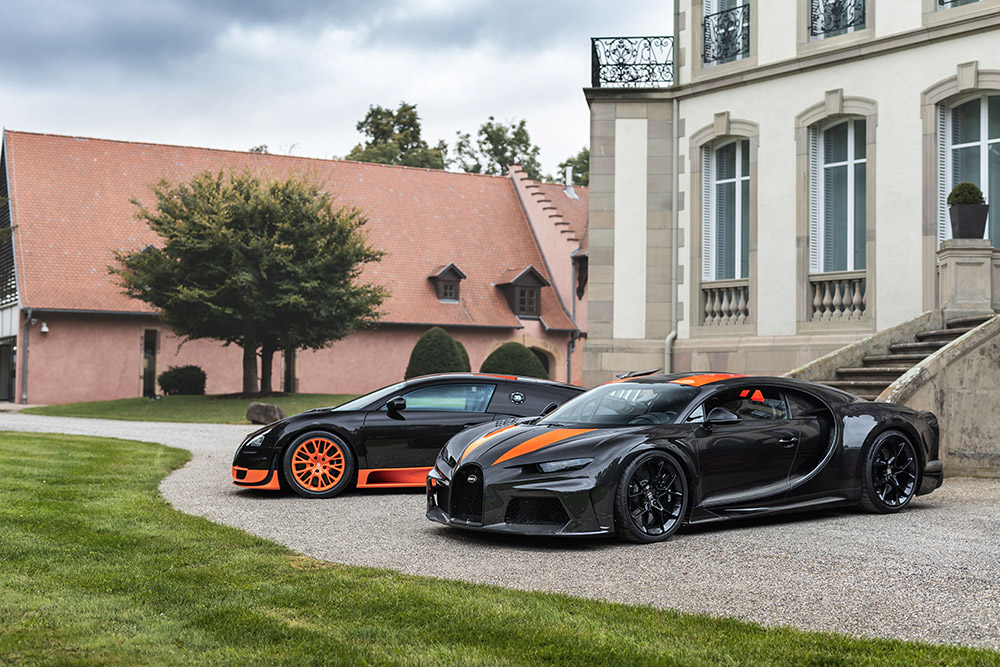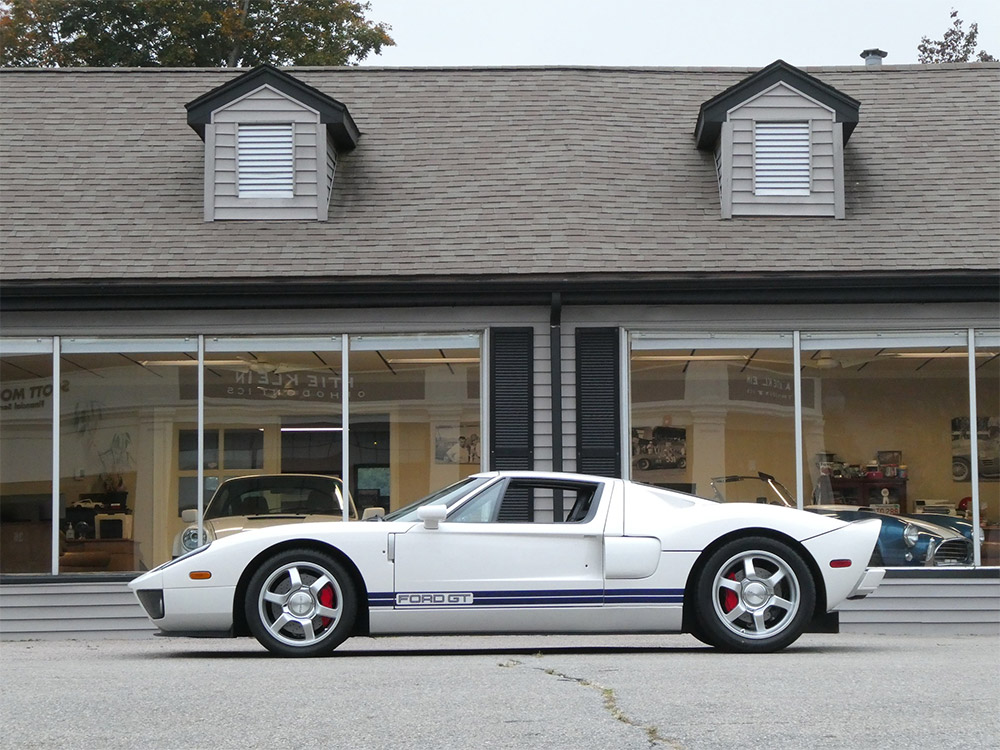The digital speedometer shows 304.77 miles per hour. 490.484 km/h. In summer 2019, the practically impossible became possible with the Bugatti Chiron Super Sport 300+: with its hyper sports car, the French company became the first manufacturer to break the 300-mph barrier, highlighting the brand’s technically outstanding performance. A record that has yet to be broken. As unique as this record still is, it was not the first in Bugatti’s history. Bugatti is a brand of superlatives and has been spearheading automotive engineering for over 110 years, with Ettore Bugatti as its ingenious designer.

100 km/h
In 1903, Ettore Bugatti achieved a speed of over 100 km/h in a vehicle he developed himself, the De Dietrich 60 CV Course Bugatti Type 5. The vehicle was powered by a four-cylinder engine with a 12.86-litre capacity, one ignition coil per combustion chamber, overhead valves and hopper cooling. The 60 PS two-seater was even able to achieve a top speed of 120 km/h. Only two of the racing cars were produced within two years.
120 km/h
In 1904, Ettore Bugatti and Émile Mathis developed the 40/50 PS model with a 7.5-litre four-cylinder engine under the newly founded company Hermes-Simplex. The vehicles, which could achieve speeds of over 120 km/h, competed in several races and were produced at Société Alsacienne de Construction Mécanique in Graffenstaden (SACM).

130 km/h
Between 1904 and 1906, Ettore Bugatti led the development of the Hermes-Simplex 50/60 PS models, which were available with either an 8.5-litre four-cylinder engine or an almost 9-litre four-cylinder engine. The even more powerful model with 80/90 PS generated its power in a 12-litre four-cylinder engine. This enabled the vehicles to reach speeds of over 130 km/h.
140 km/h
After the departure of Émile Mathis and the dissolution of Hermes-Simplex, Ettore Bugatti moved to Gasmotorenfabrik Deutz AG in Cologne in 1906. In the period up to 1909, several prototype cars were built in Cologne, in parallel with a racing car with a 1.3-litre capacity. In early 1909, Bugatti designed the Bugatti Deutz Prinz Heinrich Type 9 C at Deutz, a racing car that could travel at over 140 km/h. The Type 9 C made its first public appearance at the Prinz-Heinrich-Fahrt, a 1,850-kilometre endurance race for four-seater touring cars founded by Prince Albert Wilhelm Heinrich of Prussia, which is where the vehicle got its nickname.

150 km/h
Ettore Bugatti established his own vehicle brand in 1909, and one year later he again competed in the Prinz-Heinrich-Fahrt contest. With its 1.4-litre, four-cylinder engine with four-valve technology, the Bugatti Type 13 had a top speed of more than 150 km/h; its average speed on the straight in the race was 142.6 km/h (measured during a special stage). With an interruption due to the First World War, Bugatti continued to build the Type 13, which weighed only 300 kilograms, up to 1920. The brand produced over 400 units of this model, which was almost unbeatable on the race tracks at the time.
200 km/h
Bugatti showcased a brand new racing car with the Type 35. Its eight-cylinder engine with a capacity of two litres initially delivered 95 PS and powered the vehicle at speeds up to 190 km/h. With the Type 35 B, the capacity increased to 2.3 litres and a compressor helped to deliver even more power. With 140 PS, the racing car achieved speeds of over 215 km/h. Bugatti won around 2,000 races in the Type 35 in the years that followed. This makes the vehicle the most successful racing car of all time. With its Type 57 S, the Bugatti surpassed the 200 km/h mark in 1934 in a car that was intended exclusively for road use.

250 km/h
Bugatti introduced a special racing car, the Type 45, in 1929. He combined two parallel eight-cylinder engines from the Type 35 and created a 16-cylinder engine for cars, the first in Bugatti history. The 3.8-litre engine delivered 270 PS at 5,000 rpm and ensured a top speed of over 250 km/h. Bugatti predominantly used the racing car for short-distance and hill races, as the tyres were unable to cope with the high speeds over an extended period. Only two vehicles were produced.
Over 300 km/h
Ettore Bugatti first came up with some ideas for a roadworthy high-speed car that travels over 300 km/h in 1929. Technical drawings and sketches indicated that the eight-cylinder in-line engine from the Type 41 Royale in combination with a Type 50 gearbox would theoretically have achieved the targeted speed. But he did not pursue the project for economic reasons. Bugatti kept the magic number in mind for decades, before Romano Artioli later took on the mission. The Italian, who purchased the Bugatti trademark in 1987 and built the super sports car of the 1990s in the form of the EB110, broke the 300 km/h mark in 1992 and set a new speed record at 342 km/h. The EB110 featured a 3.5-litre V12 mid-engine with five valves per combustion chamber. Depending on the model and development stage, the output generated was between 560 PS in the GT and 610 PS in the Supersport (SS).
350 km/h
One year later, an EB110 SS with a power output of 610 PS (chassis 008) broke its own previous record with a new top speed of 351 km/h. An EB110 SS with a natural gas drive achieved a speed of 344.7 km/h – also a record.
Over 400 km/h
In 2005, the Bugatti Veyron became the first hyper sports car of the 2000s to achieve speeds of over 408.47 km/h. This made the Veyron, with the 8.0-litre 16-cylinder engine and a power output of 1,001 PS, the fastest series-production sports car in the world. A second key, known as the Speed Key, had to be activated in order to reach the speed of more than 400 km/h. On 26 June 2010, the Bugatti Veyron 16.4 Super Sport broke the world speed record for road-approved super sports cars. Under the supervision of Guinness World Records™ and the German TÜV, the Super Sport reached a top speed of 431.072 km/h, making it the fastest series-production sports car in the world.
In 2013, the open-top Bugatti Veyron 16.4 Grand Sport Vitesse set yet another record: reaching 408.84 km/h, it became the world’s fastest road-approved roadster.
490 km/h / 304 mph
In summer 2019, the Chiron Super Sport 300+ raised the bar to a level that has yet to be matched. With its 8.0-litre W16 engine and 1,600 PS power output, the hyper sports car from Molsheim became the first ever series-production car to reach more than 300 mph: it achieved an exactly measured speed of 304.773 mph, which corresponds to 490.484 km/h.

Over 500 km/h
In October 2020, Bugatti presented an extreme vehicle with the race track-oriented Bolide hyper sports car. This car is powered by an 8.0-litre W16 engine derived from series production with 1,850 PS. Including the engine, the minimalist body designed for maximum downforce weighs just 1,240 kilograms. The weight to power ratio is therefore an inconceivable 0.67 kilograms per PS. The experimental study of the Bolide achieves a simulated top speed of well over 500 km/h without any compromises in terms of maximum handling and maximum agility. This makes it the first Bugatti that is capable of speeds above 500 km/h. In addition to its top speed, the Bolide also stands for outstanding handling. In the simulation, the Bolide takes 3:07.1 minutes to complete a lap of Le Mans, and 5:23.1 minutes for a lap of the Nordschleife.
“In recent decades, Bugatti has shown that we build the fastest and most exclusive vehicles in the world. We are very proud of our history. However, we don’t just define ourselves by records or maximum speeds,” says Stephan Winkelmann. Hyper sports cars from Bugatti offer more than just top speeds: unimagined dimensions of performance, luxury, exclusivity, design and automotive hand craftsmanship. And Bugatti will continue to focus on this in the future.








